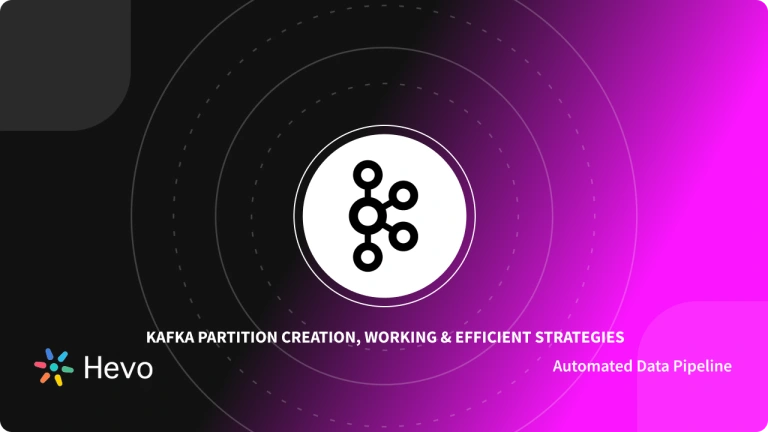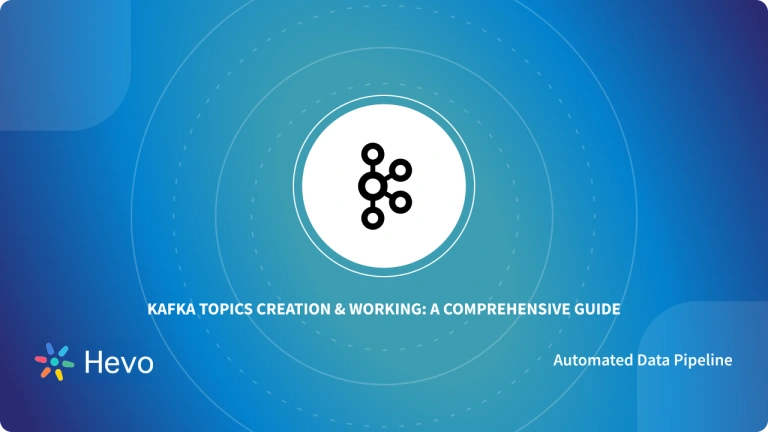Event streaming is used in industries like banking, stock exchanges, hospitals, and factories for real-time data access. Apache Kafka, a prominent real-time data streaming software, employs an open-source architecture for storing, reading, and evaluating streaming data.
Kafka handles event streams with high-level methods for transformations, aggregations, joins, and windowing. It offers high throughput, low latency, and significant compute power, effectively managing large data volumes through its distributed nature.
Kafka operates on multiple servers in a distributed architecture, utilizing the processing power and storage capacities of various systems. This structure makes Kafka a reliable tool for real-time data analysis and data streaming.
Table of Contents
What is Apache Kafka?
Apache Kafka is a Distributed Open-Source System for Publishing and Subscribing to a large number of messages from one end to the other. Kafka makes use of the Broker concept to duplicate and persist messages in a fault-tolerant manner while also separating them into subjects.
Kafka is used for creating Real-Time Streaming Data Pipelines and Streaming Applications that convert and send data from its source to its destination.
Key Features of Apache Kafka
Apache Kafka offers the following collection of intuitive features:
- Low latency: Apache Kafka has an extremely low end-to-end latency, up to 10 milliseconds, for large volumes of data.
- Seamless messaging functionality: Due to its unique ability to decouple messages and store them effectively, Kafka has the ability to publish, subscribe, and process data records in Real-Time.
- High Scalability: It refers to a system’s capacity to sustain its performance when subjected to variations in application and processing demands.
- High Fault Tolerance: Kafka is very fault-tolerant and reliable since it duplicates and distributes your data often to other servers or Brokers.
- Multiple Integrations: Kafka can interface with a variety of Data-Processing Frameworks and Services, including Apache Spark, Apache Storm, Hadoop, and Amazon Web Services.
Transform your data pipeline with Hevo’s no-code platform, designed to seamlessly transfer data from Apache Kafka to over destinations such as BigQuery, Redshift, Snowflake, and many others. Hevo ensures real-time data flow without any data loss or coding required.
Why Choose Hevo for Kafka Integration?
- Simple Setup: Easily set up data pipelines from Kafka to your desired destination with minimal effort.
- Real-Time Syncing: Stream data continuously to keep your information up-to-date.
- Comprehensive Transformations: Modify and enrich data on the fly before it reaches your destination.
Let Hevo handle the integrations.
Get Started with Hevo for FreeWhat is Kafka Clusters?
Kafka with more than one broker is called Kafka Cluster. It can be expanded and used without downtime.
It is used to manage the persistence and replication of messages of data, so if the primary cluster goes down, other Kafka Clusters can be used to deliver the same service without any delay.
Kafka Clusters Architecture Explained: 5 Major Components

In a Distributed Computing System, a Cluster is a collection of computers working together to achieve a shared goal. A Kafka cluster is a system that consists of several Brokers, Topics, and Partitions for both.
The key objective is to distribute workloads equally among replicas and Partitions. Kafka Clusters Architecture mainly consists of the following 5 components:
1) Topics
- A Kafka Topic is a Collection of Messages that belong to a given category or feed name. Topics are used to arrange all of Kafka’s records. Consumer apps read data from Topics, whereas Producer applications write data to them.
- In Kafka, Topics are segmented into a customizable number of sections called Partitions. Kafka Partitions allow several users to read data from the same subject at the same time.
- The Partitions are arranged in a logical sequence. When configuring a Topic, the number of divisions is provided, however, it may be adjusted later.
- The Partitions that make up a Topic are dispersed among the servers of the Kafka Clusters. Each server in the cluster is in charge of its own data and Partition requests. When a Broker receives the messages, it also receives a key.
- The key can be used to indicate which Partition a message should be sent to. Messages with the same key are sent to the same Partition. This allows several users to read from the same Topic at the same time.
2) Broker
- The Kafka Server is known as Broker, which is in charge of the Topic’s Message Storage. Each of the Kafka Clusters comprises more than one Kafka Broker to maintain load balance. However, since they are stateless, ZooKeeper is used to preserve the Kafka Clusters state.
- It’s usually a good idea to consider Topic replication when constructing a Kafka system. As a result, if a Broker goes down, its Topics’ duplicates from another Broker can fix the situation.
- A Topic with a Kafka Replication Factor of 2 will have one additional copy in a separate Broker. Further, the replication factor cannot exceed the entire number of Brokers accessible.
3) Zookeeper
- The Consumer Clients’ details and Information about the Kafka Clusters are stored in a ZooKeeper. It acts like a Master Management Node where it is in charge of managing and maintaining the Brokers, Topics, and Partitions of the Kafka Clusters.
- The Zookeeper keeps track of the Brokers of the Kafka Clusters. It determines which Brokers have crashed and which Brokers have just been added, as well as their lifetime.
- Then, it notifies the Producer or Consumers of Kafka queues about the state of Kafka Clusters. This facilitates the coordination of work with active Brokers for both Producers and Consumers.
- Zookeeper also keeps track of which Broker is the subject Partition’s Leader and gives that information to the Producer or Consumer so they may read and write messages.
4) Producers
- Within the Kafka Clusters, a Producer Sends or Publishes Data/Messages to the Topic. Different Kafka Producers inside an application submit data to Kafka Clusters in order to store a large volume of data.
- It is important to note that the Kafka Producer delivers messages as quickly as the Broker can handle them. It does not wait for the Broker to acknowledge them.
- When a Producer adds a record to a Topic, it is published to the Topic’s Leader. The record is appended to the Leader’s Commit Log, and the record offset is increased. Each piece of data that comes in will be piled on the cluster, and Kafka only exposes a record to a Consumer when it has been committed.
- Hence, it is crucial that Producers must first obtain metadata about the Kafka Clusters from the Broker before sending any records. The Zookeeper metadata identifies which Broker is the Partition Leader, and a Producer always writes to the Partition leader.
5) Consumers
- A Kafka Consumer is someone who Reads or Consumes the Kafka Clusters Messages. Typically, Consumers have the option of reading messages starting at a certain offset or from any offset point they desire. As a result, customers can join the Clusters at any moment.
- In Kafka, there are two categories of Consumers. The first is the Low-Level Consumer, which specifies Topics and Partitions as well as the offset from which to read, which can be either fixed or variable.
- Next, we have High-Level Consumer (or Consumer groups), which consist of one or more Consumers.
- The Broker will distribute messages based on which Consumers should read from which Partitions, as well as keeping track of the group’s offset for each Partition. It keeps track of this by requiring all customers to declare which offsets they have handled.
Challenges in Managing Kafka Clusters
1. Scalability Issues
Problem : As data volumes grow, scaling Kafka clusters becomes more difficult. The complexity increases because rebalancing data across multiple brokers is necessary to maintain performance. The process may be difficult as the load on the system rises .
Solution: Leverage automated tools, such as Cruise Control for Kafka, that can optimize resource distribution. It also automatically rebalances partitions. Leverage Kafka’s native horizontal scaling by using more brokers in your cluster when the load of data increases.
2. Data Loss Prevention
Problem: Kafka uses data replication to prevent data loss, but if it’s not properly configured, there’s a risk of losing data when brokers fail or nodes go offline. Proper setup is crucial to ensure data safety during these failures.
Solution: In order to allow each topic to replicate data over a number of nodes, the replication factor of each topic will need to be increased. Because enabling the setting for acknowledgment allows control over when data has been committed, and other settings such as min.insync.replicas-are available that ensure data is written to a minimum amount of replicas before being confirmed.
3. Complexity of Broker and Cluster Configuration
Challenge: Broker setup, including memory, CPU, and network configuration parameters, can be very complex; incorrect tuning almost always leads to performance degradation.Solution: Utilize automated configuration management tools such as Ansible, Puppet, or Chef to manage your Kafka cluster configurations in a uniform manner. Also, the main metrics—disk I/O, memory usage, and CPU load are subject to monitoring in order to perform proactive tuning of the configuration.
Conclusion
In this blog, you learned about Apache Kafka Clusters architecture, including concepts like Topics, Broker, Producers, and Consumers.
Thousands of organizations use Apache Kafka to solve their big data problems.
Understanding Kafka Clusters Architecture can assist you to better handle streams of data and implement data-driven applications effectively.
FAQs
1. How many partitions can a Kafka cluster have?
Kafka clusters can have thousands of partitions, but the exact number depends on your hardware capabilities and how well you manage them.
2. Can a Kafka cluster work without ZooKeeper?
Kafka still requires ZooKeeper for coordination, but newer versions are moving towards a ZooKeeper-less setup called KRaft mode.
3. What does a Kafka cluster consist of?
A Kafka cluster is made up of multiple brokers (servers), partitions that store data, ZooKeeper for managing the cluster, and producers and consumers that send and receive data.









